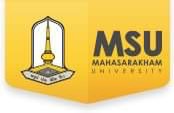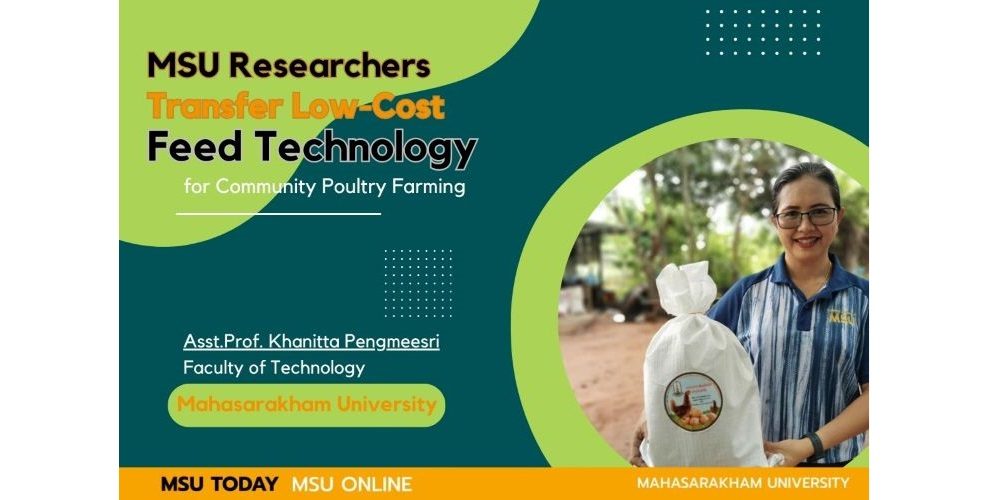MSU Researchers Transfer Low-Cost Feed Technology for Community Poultry Farming
Researchers from Mahasarakham University (MSU) visited the community to transfer low-cost feed technology for raising chickens to a group of local villagers in Na Pho Subdistrict, Kut Rang District, Maha Sarakham Province. In the current era of rising food production costs, developing new, efficient, and low-cost feed production methods is crucial for farmers and businesses in the poultry industry. Researchers from MSU have researched and developed new innovations designed to reduce the cost of producing feed for laying hens while maintaining high nutritional value and egg production efficiency.
This low-cost feed not only helps reduce expenses in raising chickens but also promotes sustainability in animal feed production by utilizing local raw materials and advanced technology to create suitable and efficient feed formulas, benefiting farmers who seek greater value in their business. Led by Asst.Prof. Khanitta Pengmeesri from the Faculty of Technology, MSU, and Assoc.Prof. Songsak Chumpawadee, an animal nutritionist and head of the Department of Agricultural Technology, MSU.

What inspired you to start this research project?
In modern agriculture the cost of purchasing commercial livestock feed is quite high, especially for poultry where feed can account for over 70% of production costs. Normally, farmers have to buy commercially prepared food to feed chickens so that they receive complete nutrition and lay eggs.
Project name
Low-Cost Feed Technology Transfer Project for Community Chicken Farming
Project objectives
To enable poultry farmers to reduce feed costs while ensuring chickens receive complete nutrition to enhance high-quality production.

How is low-cost feed produced?
Low-cost feed is formulated with a concentrated nutritional mix, containing 34% protein, including 8 kg of difficult to source ingredients, such as lysine, methionine, and various minerals and vitamins. Farmers must source energy-rich ingredients and primary materials, such as 24 kg of ground rice hulls or bran, which can be cheaply produced or sourced locally. When mixed with the concentrated feed, the result is 18% protein feed, meeting the needs of laying hens, along with essential vitamins, minerals and calcium.
How are the main ingredients for low-cost feed selected?
In addition to essential minerals, vitamins, and nutrients for quality egg production, we also use dried Leucaena leaves as a key ingredient. These leaves are high in protein and contain pigments that enhance the color of egg yolks, making them both cost-effective and beneficial for egg color.

How can low-cost feed technology improve community poultry production?
This low-cost feed is nutritionally calculated based on the needs of laying hens by Assoc.Prof. Songsak Chumpawadee, an animal nutritionist. Therefore, using concentrated low-cost protein feed can reduce feed costs by 28% compared to commercial feeds.
How important is the management of low-cost feed technology in community poultry production?
The production process is not complex, but the feed ingredients must follow a specific formula. If poultry farmers scale up their operations, they can produce this concentrated low-cost feed for other group members, generating income within the group. MSU is ready to provide ongoing consultancy.

What future opportunities might this research bring?
If a group of egg producers is established, with producers of low-cost concentrated protein feed and a market for the eggs, a circular economy within the community will emerge. The community will reduce reliance on commercial feed, lower feed costs, and thus increasing the profit margin.

What is the most important benefit of using low-cost feed technology in poultry production?
The essential parts of using low-cost feed technology consist of two components: First, the production of this low-cost concentrated feed must follow a specific formula. Second, unlike commercial feed, which farmers can simply scoop and use or mix with scraps and natural feed, low-cost concentrated protein feed requires farmers to prepare and mix additional ingredients, such as ground rice. This adds additional steps to the process. From enquiries with farmers, it was found that some farmers find mixing convenient, while others do not. Therefore, the target group for this technology is farmers who both understand the importance of poultry nutrition and have access to energy-rich raw materials like ground rice or bran.

Has this research been implemented in the community, and what has the feedback been like?
Last year, we tested this low-cost concentrated protein feed in the Ban Lao Iman community, Nong Mek Subdistrict, Na Chueak District, Maha Sarakham Province. Farmers showed interest in using the feed, and there were additional purchases of concentrated protein feed after the knowledge transfer sessions were completed. However, there has not yet been any promotion for the group to produce and sell the feed on their own.
What would you like to share about this project with those interested?
This low-cost concentrated protein feed for laying hens is designed to help poultry farmers reduce production costs by using raw materials available in each household as a feed source for their chickens. This reduces dependence on commercial feed and is convenient to use. By mixing 1 bag (8 kg) of concentrated protein feed with 24 kilograms of ground rice or rice bran, farmers can produce nutritionally complete feed equivalent to commercial feed but at a lower cost.

“The community will become strong and self-reliant if we all work together to drive and develop the community with true knowledge. Then, the community will become strong and sustainably self-reliant.”
Original Thai Article: https://news.msu.ac.th/msumagaz/smain/readpost.php?mid=615



Leave a Reply